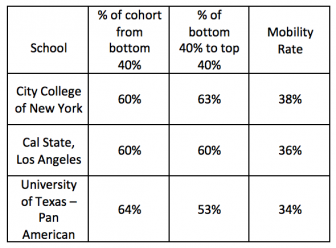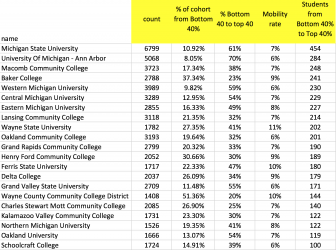In my last post I analyzed an important data set recently released by economist Raj Chetty and colleagues, that measures every college’s contribution to economic mobility in America. I looked at the percentage of the poorest students in each cohort at Michigan colleges who, by their early thirties, were in the top 40% of earners.
The results were fairly disappointing because the Michigan institutions that had the greatest impact on the mobility of their poorest students were selective institutions that enrolled very few low-income students. At U of M and MSU, over 60% of the poorest students who enroll make it to the top 40%, but less than 5% of each cohort at those schools come from the bottom income quintile.
A better metric to evaluate which colleges are true engines of economic mobility, therefore, might be what the New York Times called a college’s mobility rate. This metric takes the percent of students enrolled in a college cohort from the bottom two quintiles, and then multiplies that number by the percent of these students that end up in the top 40% as adults. This measure therefore takes into account both an institution’s commitment to access and success for non-affluent students. You can’t get a high number on this metric unless you both enroll a high number of students from the bottom two quintiles, and then get a high proportion of those students into the top 40% of wage earners as adults.
On this metric, it’s clear Michigan’s higher education system has some room for improvement. The Times reported out on the institutions with the best mobility rates in the country. At The City College of New York, for example, 60% of each cohort was drawn from the bottom 40%, and 63% of those students end up in the top 40% as adults, for a mobility rate of 38%. Other colleges with the best mobility rates in the country are in the mid 30s.

No higher education institution in Michigan is even close to hitting that metric. While 70% of students in the bottom two income quintiles that enroll at the University of Michigan make it to the top 40% by their early 30s, only 8% of each class at U of M is drawn from the bottom two quintiles, leaving U of M with a mobility rate of just 6%. Michigan State’s mobility rate is at just 7%, with 11% of each class coming from the bottom two income quintiles, and 60% of those students making it to the top 40% as adults. At Wayne State University, 27% of each class is drawn from the bottom 40%, but just 41% make it to the top two quintiles as adults, for a mobility rate of 11%.
Below I’ve listed all of the institutions that move at least 100 bottom 40% kids from each cohort into the top 40% as adults. As you can see, however, all of these schools have low mobility rates. Schools like Michigan State and the University of Michigan have a low mobility rate because they don’t enroll enough non-affluent students (though these numbers reflect students who enrolled in college in the late 90s, and both schools have made recent efforts to increase the number of low-income students they enroll). Community colleges and Wayne State University enroll higher proportions of non-affluent students, but have low rates of moving those students to the top 40% of earners as adults. As I mentioned in my last post, my guess is that this is because these institutions have low completion rates, so many students that attend don’t receive the economic benefits that come with earning a college degree.

As the data from the national leaders demonstrates, to truly serve as an engine of economic mobility colleges need to enroll a high proportion of non-affluent students, and then ensure a high proportion of those students leave with a degree. At the moment, we don’t have any colleges in Michigan that are doing both of these things well. Yet in an economy in which the returns to a college degree continue to increase, and too many students are left out, doing both of these things well may be our central challenge.







